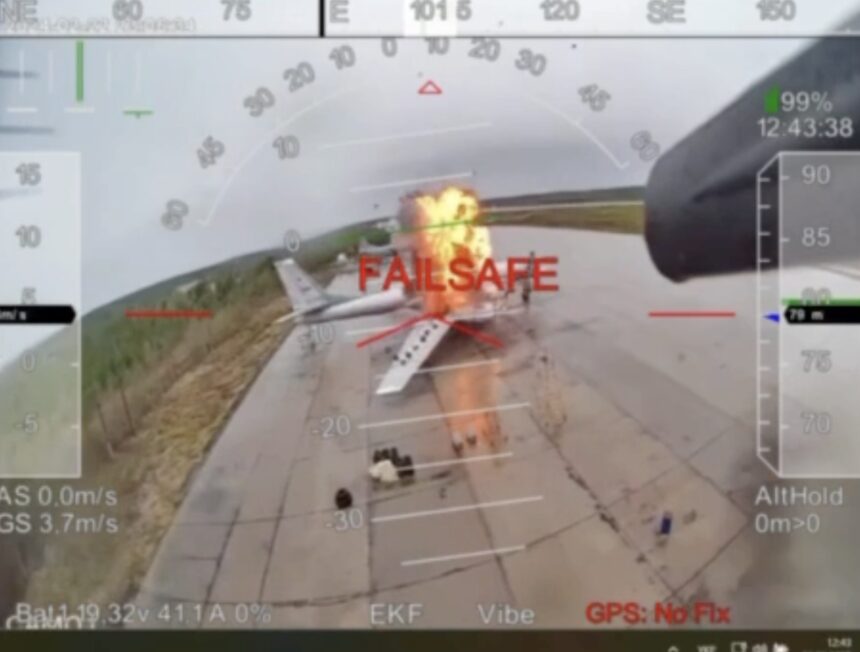In a dramatic escalation of Ukraine’s defensive capabilities, Ukrainian forces have reportedly executed one of their most significant strikes against Russian military infrastructure since the conflict began. An overnight drone attack on a Russian airbase has resulted in extensive damage to over 40 Russian warplanes, according to Ukrainian intelligence sources and satellite imagery analysis.
The precision strike targeted the Engels-2 airbase, located deep within Russian territory approximately 600 kilometers from the Ukrainian border. This strategic facility has long served as a launching point for air operations against Ukrainian cities and infrastructure. What makes this attack particularly remarkable is not just the number of aircraft damaged, but the extraordinary range displayed by Ukraine’s evolving drone program.
“This represents a watershed moment in asymmetric warfare capabilities,” noted defense analyst Mikhail Kovalenko in a statement to CO24. “Ukraine has demonstrated it can now reach targets previously considered safely beyond their operational range, fundamentally altering Russia’s strategic calculations.”
Satellite imagery reviewed by independent military observers confirms substantial damage to numerous aircraft, including Tu-95 and Tu-160 strategic bombers—critical components of Russia’s long-range strike capability that have been routinely employed to launch cruise missiles against Ukrainian civilian infrastructure.
The Russian Defense Ministry has acknowledged an incident at the base but significantly downplayed the extent of the damage, claiming only “minor damage to ground equipment” with “no casualties reported.” However, multiple intelligence sources contradict this assessment, suggesting the strike has temporarily diminished Russia’s strategic bombing capacity by approximately 25 percent.
Ukrainian President Volodymyr Zelensky, while not explicitly claiming responsibility for the strike, delivered a pointed message during his nightly address: “Those who bring destruction to our cities cannot expect their military assets to remain safe, regardless of distance.”
The technical achievement cannot be overstated. Ukraine’s indigenous drone program has evolved rapidly since the war began, progressing from small tactical units to sophisticated long-range systems capable of evading Russian air defenses. Military experts suggest this particular operation likely involved a new generation of stealth drones designed specifically to penetrate advanced radar systems.
The timing of this strike coincides with intensified Russian missile campaigns against Ukrainian energy infrastructure as winter approaches. By targeting the very aircraft that launch these missiles, Ukraine appears to be implementing a strategy aimed at degrading Russia’s ability to continue these systematic attacks on civilian power systems.
International reaction has been measured but significant. NATO officials have privately expressed surprise at the technological sophistication demonstrated, while publicly maintaining their position of supporting Ukraine’s right to self-defense. The U.S. State Department reiterated that Ukraine has legitimate authority to strike military targets used to launch attacks against its territory.
For ordinary Russians, this strike represents a rare instance of the war directly affecting military installations deep within their country, potentially challenging the carefully constructed narrative that military operations remain confined to Ukrainian territory.
The strategic implications of this strike extend beyond the immediate tactical victory. Russia will likely be forced to relocate valuable aircraft assets further from the Ukrainian border, complicating logistics and potentially reducing operational effectiveness. Additionally, significant resources may need to be diverted to bolster air defense systems protecting these bases—resources that would otherwise be deployed to the front lines.
As winter settles across Eastern Europe and both sides prepare for continued conflict, this demonstration of Ukraine’s expanding capabilities raises a profound question: How will Russia’s military leadership respond to the revelation that their strategic depth—long considered an insurmountable advantage—may no longer provide the security they have relied upon throughout this conflict?

























